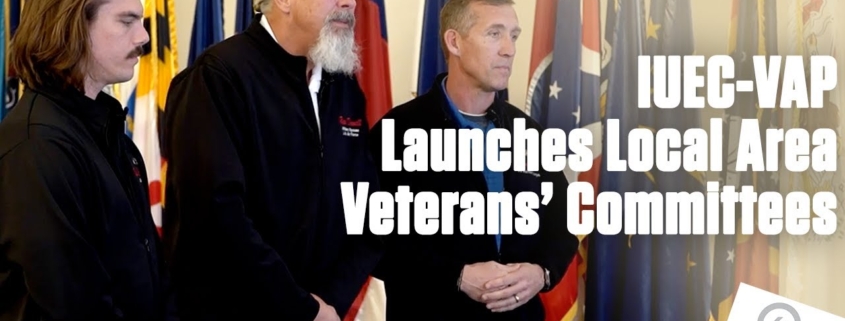Today marks the first annual National Elevator Mechanics Day. ElevatorInfo is proud to celebrate IUEC mechanics, the industry’s leading elevator mechanics. With their skills, professionalism, education, and dedication, they take great pride in their work, which keeps elevators, escalators, and all types of conveyance equipment running smoothly and safely for the riding public.
To celebrate National Elevator Mechanics Day, we’ve put together a list of five things you didn’t know about IUEC elevator mechanics.
1. Their work encompasses skills from all of the building trades
Being an elevator mechanic is an elite profession. IUEC elevator mechanics go through rigorous training and education to hone their skills and prepare themselves to excel in the field. Through the USDOL Registered National Elevator Industry Educational Program (NEIEP) apprenticeship, they receive extensive safety training and go through the most comprehensive, hands-on program in the industry.
Their NEIEP education gives them the skills and foundational background theory and knowledge needed to work on elevator and escalator equipment from the early 1900s through to today’s cutting-edge technology. Once they complete their apprenticeship and pass a capstone Mechanic Exam – earning journeyman mechanic status – they continue learning throughout their careers by participating in NEIEP’s Continuing Education (CE) courses, where they can build on those skills and earn important industry-related certifications. Because of their NEIEP education, IUEC elevator mechanics possess unique and diverse skill sets that prepare them to take on any project, regardless of its complexity.
2. To reach mechanic status, they complete college-level training
As mentioned, IUEC elevator mechanics go through a rigorous apprenticeship via NEIEP, but did you know that this education translates to a college-level education? NEIEP’s apprenticeship program leads the industry, which is why colleges such as the Community College of Baltimore County, Ivy Tech Community College, Rowan University, Thomas Edison State University, the University of Nebraska at Omaha, and Wentworth Institute of Technology have partnered with NEIEP.
These colleges and universities provide college credit for the work completed as a student in the NEIEP apprenticeship program. Students at these institutions can receive up to 45 college transfer credits to use at that school (the number of credits depends on which of the colleges or universities they choose), which can sometimes account for more than 50% of the credits needed to complete their degree. Construction Craft Professional (AAS), Applied Science (AAS), Construction Management (BA), Project Management (BA), and Engineering Technology (AAS) are just some of the options NEIEP graduates have when it comes to continuing their education through one of the program’s college partnerships.
Student debt has been a big issue for many young people coming into the workforce for the first time or experienced workers wanting to make a career change later in their lives – but construction apprenticeship programs like NEIEP allow them to pursue a quality education without that burden. As all of their apprenticeship-related expenses are covered by their IUEC education benefits, aspiring mechanics entering the elevator trade are able to “earn while they learn” and don’t graduate from their apprenticeship training burdened by loans they must repay. If they choose to continue their post-apprenticeship education through one of NEIEP’s college partnerships, the costs they incur for their college courses are greatly reduced by the head start they have in pursuing their degrees.
3. Many come from military backgrounds
Through work with programs like Helmets to Hardhats (H2H), many Veterans of the U.S. armed forces join the elevator trade where they put the skills they learned in the military to use. Some IUEC elevator mechanics have backgrounds as aircraft mechanics, nuclear submarine engineers, and tank commanders. The highly-technical skills that these professionals bring to the IUEC help solidify IUEC elevator mechanics as the most skilled, talented, and dedicated in the industry.
Much of the work involved in elevator and escalator installation, maintenance, service, and repair requires technical expertise, mechanical aptitude, and the ability to follow serious safety protocols — skills that people in the military develop and use extensively during their service. Veterans from all branches of the military have experience learning new technologies, troubleshooting equipment under pressure, following directions from their supervisors, adapting to challenging situations, and collaborating with their team, making them valuable assets to IUEC-affiliated elevator companies.
Once Veterans enter the trade, the IUEC’s Veterans Assistance Program steps in to assist them with applying for the GI Bill benefits they are eligible to receive as they participate in NEIEP apprenticeship courses. The IUEC-VAP also helps IUEC Veteran members and Veteran spouses through the application process for claims and disabilities.
IUEC-VAP National Chairman Jason Gray, IUEC National Organizer, Local 32 member, and U.S. Marines Corps Veteran, said “We are looking to help Veterans in all aspects of their needs. A lot of Veterans don’t understand there are benefits that are available to them…our plan is to get the word out and let Veterans know we’re going to be a resource for them if they have a need that’s related to their military service. We want to be that community they can go to seek assistance.”
4. They’re experts at staying safe in hazardous conditions
For the riding public, elevators are the safest form of transportation in the world. But because the safety features in place for riders are typically disabled to allow elevator constructors to perform their work, they must remain vigilant of the hazards they encounter on the jobsite every day.
According to the Occupational Safety and Health Administration (OSHA), construction is at the top of the list for the most dangerous industries to work in in the United States. Construction inspections make up approximately 60% of all of the workplace inspections they perform every year. The agency describes its “Fatal 4” hazards in relation to construction jobs: falls from heights, caught in or between, struck-by, and electrical hazards. IUEC mechanics regularly encounter these dangers while working on elevators, escalators, and other conveyance systems.
Other common issues on jobsites include the risk of being injured by unguarded machinery, injuries that result from the improper use of power tools or hand tools, hearing damage from loud noises generated during construction or repair work, confines spaces, extreme weather conditions, eye damage from dust or debris, exposure to silica dust, asbestos, chemicals, bloodborne pathogens – the hazards these workers face are omnipresent. This is why the IUEC and its signatory companies work together to ensure all elevator constructors are educated of the risks and have the knowledge and materials necessary to take preventative measures to avoid them – such as lock out tag out (LOTO), the use of personal protective equipment (PPE), and emergency action plans. They always perform a job hazard analysis (JHA) before beginning any job to ensure their diverse skills can be put to work in a safe working environment.
As part of a continued effort to promote a culture of working safe, the IUEC established a department dedicated to safety as well as an international safety committee and Local Area Safety Committees at IUEC Locals across the United States and Canada. ElevatorInfo reported on an initiative from the IUEC Safety Director and Assistant Safety Director building on OSHA’s work. They developed BE SAFE, a safety-focused awareness campaign designed specifically for the people who install, service, maintain, troubleshoot, repair, and inspect elevators, escalators, and other conveyance equipment.
“BE SAFE is a phrase that we use when we’re saying goodbye to one another – hey brother, hey sister, be safe,” said IUEC Safety Director Eric McClaskey. “We took those words and we wanted to associate hazards within the industry as a reminder for mechanics and apprentices out in the field… BE SAFE really brings everything together for our safety culture, because within BE SAFE we have the OSHA Focus Four hazards where we see most of the injuries and fatalities in the industry – so we’re really trying to build upon that within (the IUEC) safety committee, local safety committees, and even within our alliance with OSHA.”
The major hazards they identified for elevator constructors included:
- Barricades – Are proper barricades in place?
- Elevator location – Have you identified/verified the elevator’s location prior to entering the hoistway?
- Struck by – Is overhead protection in place?
- Adjacent car – Is adjacent car protection in place?
- Fall protection – Are you using a Personal Fall Arrest System (PFAS) where fall hazards exist?
- Electrical protection – Are you using electrical safe work practices?
5. They don’t just work on elevators and escalators
Dumbwaiters, moving walks, Automated People Mover trams at airports, cruise ship elevators, shopping cart lifts at department stores in large cities, pinsetters in bowling alleys, conveyor belt systems, carnival rides – these are all examples of equipment that IUEC elevator constructors have performed work on in addition to the elevators and escalators they’re known for.
Thanks to their skills and high level of craftsmanship, IUEC elevator mechanics are the best choice to install and maintain wind tower conveyance systems in onshore and offshore turbines across the United States. Through a collaborative learning program with Survival Systems USA in Groton, CT, IUEC mechanics can enroll in Global Wind Organization Basic Safety Training (GWO-BST), which includes modules such as Basic Safety Training, Work at Height, Manual Handling, Medic First Aid + Trauma, Fire Awareness, Sea Survival, Enhanced First Aid, and Advanced Rescue Training. This training, which culminates in an internationally-recognized wind industry credential, prepares IUEC mechanics to excel at wind turbine work and other types of projects.
Join us and celebrate IUEC elevator mechanics
While you may not have known each of these five facts about IUEC elevator mechanics, one thing you should know by now is that because of their top-tier training and dedication to their craft, IUEC mechanics are the best in the industry. On the first annual National Elevator Mechanics Day, we honor them, not just for the work they do every day in making elevators, escalators, and moving walkways safe for the riding public, but also for the dedication and capability each of them has demonstrated as the industry’s leading elevator mechanics.


